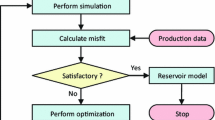Abstract
Closed-loop production management combines the process of history matching and production optimization together to periodically updates the reservoir model and determine the optimal control strategy for production development to realize the goal of decreasing the knowledge of model uncertainty as well as maximize the economic benefits for the expected reservoir life. The adjoint-gradient-based methods seem to be the most efficient algorithms for closed-loop management. Due to complicated calculation and limited availability of adjoint-gradient in commercial reservoir simulators, the application of this method is still prohibited for real fields. In this paper, a simultaneous perturbation stochastic approximation (SPSA) algorithm is proposed for reservoir closed-loop production management with the combination of a parameterization way for history matching and a covariance matrix to smooth well controls for production optimization. By using a set of unconditional realizations, the proposed parameterization method can transform the minimization of the objective function in history matching from a higher dimension to a lower dimension, which is quite useful for large scale history matching problem. Then the SPSA algorithm minimizes the objective function iteratively to get an optimal estimate reservoir model. Based on a prior covariance matrix for production optimization, the SPSA algorithm generates a smooth stochastic search direction which is always uphill and has a certain time correlation for well controls. The example application shows that the SPSA algorithm for closed-loop production management can decrease the geological uncertainty and provide a reasonable estimate reservoir model without the calculation of the adjoint-gradient. Meanwhile, the well controls optimized by the alternative SPSA algorithm are fairly smooth and significantly improve the effect of waterflooding with a higher NPV and a better sweep efficiency than the reactive control strategy.
Similar content being viewed by others
References
Chen Y, Oliver D, Zhang D. Efficient ensemble-based closed-loop production optimization. SPE J, 2009, 14(4): 634–645
Brouwer D, Naevdal G, Jansen J, et al. Improved reservoir management through optimal control and continuous model updating. SPE 90149-MS, 2004
Chen C, Wang Y, Li G, et al. Closed-loop reservoir Management on the Brugge test case. Comput Geosci, 2010, 14: 691–703
Jansen J, Douma S, Brouwer D, et al. Closed-loop reservoir management. SPE 119098, 2009
Peters E, Arts R, Brouwer G, et al. Results of the Brugge benchmark study for flooding optimization and history matching. SPE 119094, 2009
Sarma P, Durlofsky L, Aziz K. Efficient closed-loop production optimization under uncertainty. SPE-94241, 2005
Wang C, Li G, Reynolds A C. Production optimization in closed-loop reservoir management. 2007 SPE Annual Technical Conference and Exhibition, SPE 109805, 2007
Zhang F, Reynolds A. Optimization algorithms for automatic history matching of production data. Proceedings of 8th European Conference on the Mathematics of Oil Recovery, 2002
Gao G, Reynolds A. An improved implementation of the LBFGS algorithm for automatic history matching. SPE J, 2006, 11(1): 5–17
Tavakoli R, Reynolds A C. History matching with parameterization based on the SVD of a dimensionless sensitivity matrix. SPE J, 2010, 15(2): 495–508
Gao G, Li G, Reynolds A. A stochastic algorithm for automatic history matching. SPE J, 2007, 12(2): 196–208
Li G, Reynolds A. Uncertainty quantification of reservoir performance predictions using a stochastic optimization algorithm. Comput Geosci, 2010, 15: 378–390
Gao G, Zafari M, Reynolds A. Quantifying uncertainty for the PUNQ-S3 problem in a Bayesian setting with RML and EnKF. SPE-93324, 2005
Gu Y, Oliver D. The ensemble Kalman filter for continuous updating of reservoir simulation models. J Energy Res Technol, 2006, 128(1): 79–87
Gu Y, Oliver D. An iterative ensemble Kalman filter for multiphase fluid flow data assimilation. SPE J, 2007, 12(4): 438–446
Liu N, Oliver D. Critical evaluation of the ensemble Kalman filter on history matching of geologic facies. SPE Reserv Eval Eng, 2005, 8(4): 470–477
Zafari M, Li G, Reynolds A. Iterative forms of the ensemble kalman filter. Proceedings of the 10th European Conference on the Mathematical Oil Recovery Amsterdam, 2006
Zafari M, Reynolds A. Assessing the uncertainty in reservoir description and performance predictions with the ensemble Kalman filter. Proceedings of the 2005 SPE Annual Technical Conference and Exhibition. SPE 95750, 2005
Naevdal G, Johnsen L, Aanonsen S. Reservoir monitoring and continuous model updating using ensemble Kalman filter. 2003 SPE Annual Technical Conference and Exhibition. SPE 84372, 2003
Naevdal G, Mannseth T, Vefring E H, et al. Near-well reservoir monitoring through ensemble Kalman filter. SPE 75235, 2002
Zhao Y, Reynolds A, Li G. Generating facies maps by assimilating production data and seismic data with the ensemble Kalman filter. SPE 113990, 2008
Brouwer D, Jansen J. Dynamic optimization of waterfooding with smart wells using optimal control theory. SPE J, 2004, 9(4): 391–402
Sarma P, Durlofsky L, Aziz K. Implementation of adjoint solution for optimal control of smart wells. SPE 92864, 2005
Wang C, Li G, Reynolds A. Optimal well placement for production optimization, SPE J, 2009, 14(3): 506–523
Leeuwenburgh O, Egberts P, Abbink O A. Ensemble methods for reservoir life-cycle optimization and well placement. SPE 136916, 2010
Asadollahi M, Navedal G, Markovinovic R, et al. A work flow for efficient initialization of local search iterative methods for waterflooding optimization. Proceedings of the 2009 International Petroleum Technical Conference, 2009. IPTC13994
Oliver D, Reynolds A, Liu N. Inverse Theory for Petroleum Reservoir Characterization and History Matching. New York: Cambridge University Press, 2008
Spall J. Multivariate stochastic approximation using a simultaneous perturbation gradient approximation. IEEE Trans Automat Control, 1992, 37(3): 332–341
Spall J. Implementation of the simultaneous perturbation algorithm for stochastic optimization. IEEE Trans Aerosp Electron Syst, 1998, 34(3): 817–823
Nocedal J, Wright S J. Numerical Optimization. New York: Springer, 1999
Christalkos G. Random Field Models in Earth Sciences. San Diego, CA: Academic Press, 1992
Author information
Authors and Affiliations
Corresponding author
Rights and permissions
About this article
Cite this article
Zhao, H., Li, Y., Yao, J. et al. Theoretical research on reservoir closed-loop production management. Sci. China Technol. Sci. 54, 2815–2824 (2011). https://doi.org/10.1007/s11431-011-4465-2
Received:
Accepted:
Published:
Issue Date:
DOI: https://doi.org/10.1007/s11431-011-4465-2




